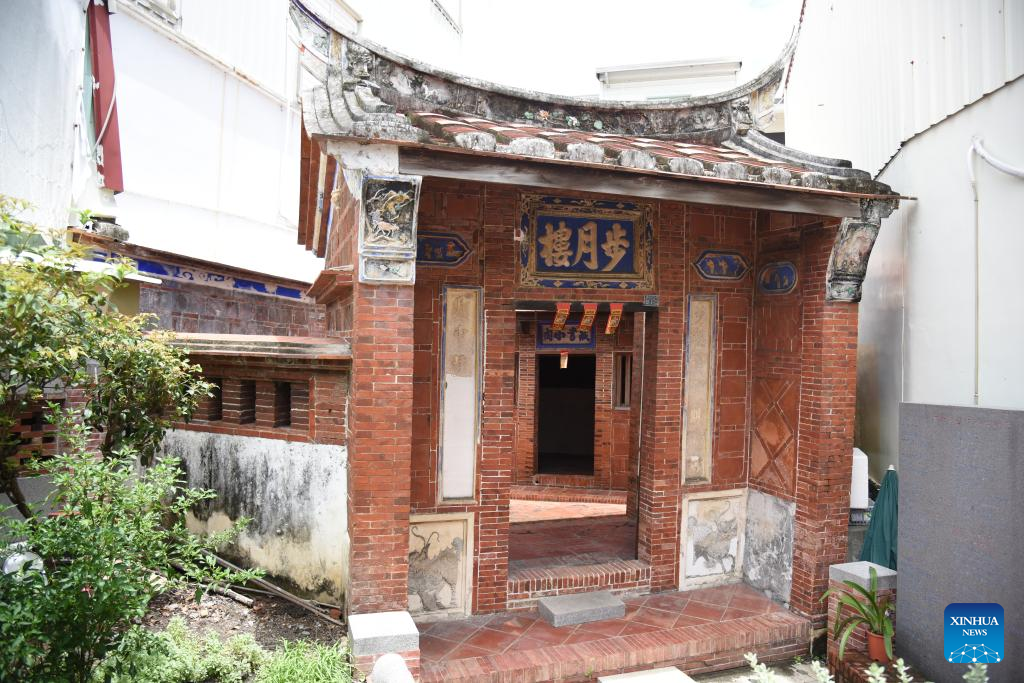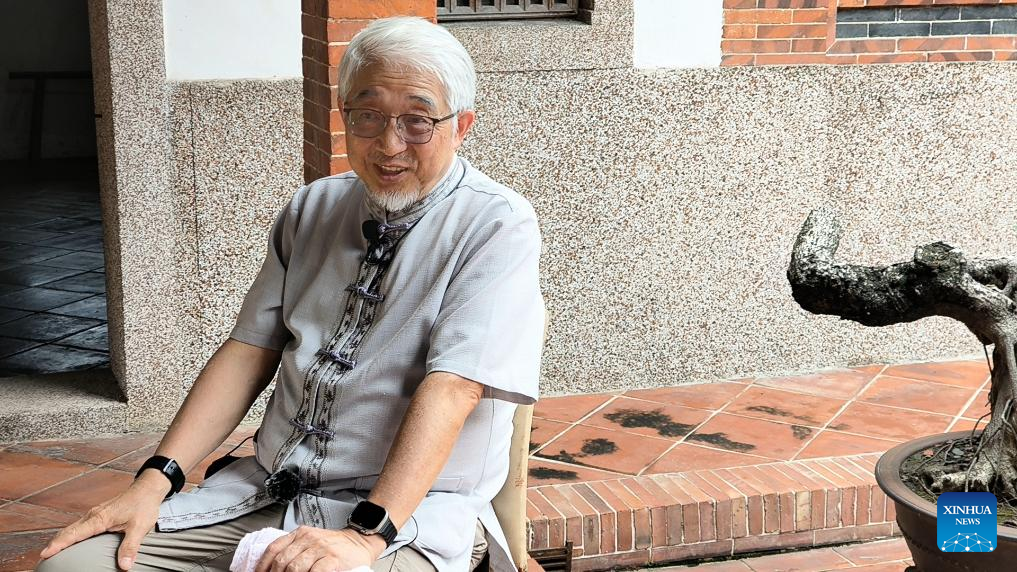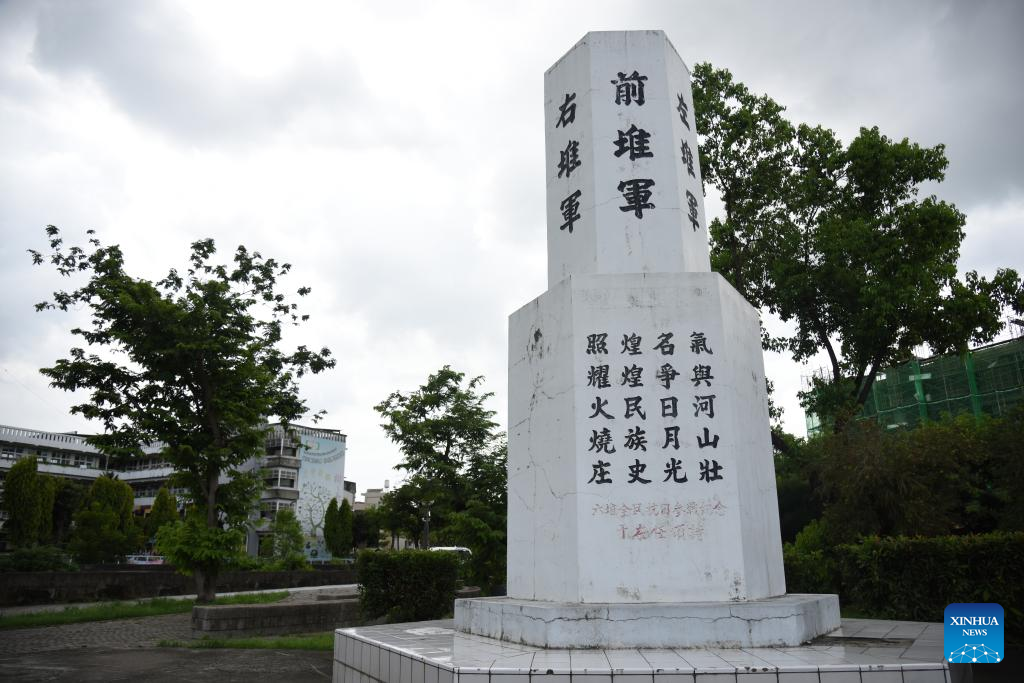Feature: Family history recalls Taiwan's heroic resistance to Japanese colonial rule
Source: Xinhua
Editor: huaxia
2025-08-23 13:01:45

A historic gatehouse named "Moon-walking Pavilion" is pictured next to the manor of the Shaw family in Pingtung County, southeast China's Taiwan, June 5, 2025. (Xinhua/Li Jianhua)
TAIPEI, Aug. 23 (Xinhua) -- Tucked away in a small township of southern Taiwan's Pingtung County, a humble and weathered gatehouse stands quietly, bearing a romantic name, "Moon-walking Pavilion."
Few today would suspect that this was once the redoubt in a battle where local villagers made a desperate and heroic stand against invading Japanese forces 130 years ago.
"It's not just a building. This land was once soaked with blood," said 73-year-old Shaw Kai-ping, great-great-grandson of Shaw Kuang-ming who led the battle against the Japanese here in 1895.
The battle was part of a brief but fierce resistance movement that erupted in Taiwan after the Qing government, defeated in a war launched by Japan against China, was forced to cede Taiwan and the Penghu Islands to Japan.
"This is where they fought," said Shaw, pausing before a wall still marked by bullet holes. "Many, like my great-great-grandfather, chose death over surrender."
The Shaw family had migrated from Guangdong Province on the mainland to southern Taiwan in 1786, eventually becoming a leading clan in the region. Their home, a sprawling manor built in a double-enclosed layout, became a battlefield in October 1895 when about 18,000 Japanese soldiers landed at the Fangliao port of Pingtung.
Local Hakka communities, led by leaders such as Shaw Kuang-ming, decided not to surrender but instead mobilized local villagers. They flooded farmland with seawater to slow down Japanese troops and staged ambushes in the jungle. When retreating to the Shaw estate, they poured boiling water and threw rocks from the top of the ramparts of the front gate.
But their resistance was tragically insufficient against the Japanese onslaught. Armed mostly with crude muskets and farming tools attached to kitchen knives, the local fighters held out for 14 hours before the Japanese stormed and torched the estate and the surrounding village. Over 100 local defenders died, including one of Shaw's sons. His other son was seriously wounded and died days later.
Local people's resistance did not end in Shaw's hometown. About 30 km away, the village of Changxing earned the name "Fireburn Village" in November 1895. The last major stand of the resistance movement was commanded there by Chiu Feng-yang.
"He was a towering 66-year-old Hakka man renowned for a booming voice and courage," said Chiu Chi-chang, his great-great-grandson.
In this final clash, Chiu led 3,000 villagers, including women, children and the elderly, against overwhelming odds. Japanese troops tried to negotiate several times, but Chiu refused. What followed was heavy artillery bombardment and the complete destruction of the settlement.
"Flames tossed like waves and smoke masked the sky," reads a historical record describing the scene. About 250 local fighters were killed, including Chiu's teenage son.
In 1968, the construction of a nearby school unearthed some remains of these fighters. Today, their remains rest in a small shrine in a park on the site of the battlefield.
Chi Chia-lin, chief of a Taiwan history research association, told Xinhua that nearly 10,000 people in Taiwan sacrificed their lives during the resistance movement in 1895, while on the Japanese side a total of 4,800 Japanese military personnel were killed and about 27,000 injured.
The 1895 resistance was suppressed -- but its patriotic spirit has been passed on through generations.
Shaw Kai-ping's father, Shaw Dao-ing, was born in Japanese-colonized Taiwan in 1916.
"Despite the colonial indoctrination of the time, my father grew up hearing whispered tales of ancestral defiance," Shaw said.
Japan invaded northeast China in 1931 and initiated a full-scale invasion of China in 1937.
In 1940, Shaw Dao-ing and his wife went to the mainland to join the resistance war against Japan, where he used his medical training to serve as a frontline medic for Chinese troops.
"My parents believed that it was their mission to fight for the motherland when it was in peril," Shaw said.
Tens of thousands of Taiwan residents followed similar paths. Between 1937 and 1945, at least 50,000 crossed the Taiwan Strait to join the war of resistance on the mainland.
The descendants of these patriotic families, including Shaw and Chiu, have strived to preserve these valuable memories. Shaw helped found an association in Taiwan for relatives of patriots who fought against Japanese aggression, which has over 30 members. Every November, villagers of Changxing, including Chiu's family, gather for a ceremony paying tribute to these past heroes.
In recent years, they have been facing growing challenges. Taiwan's Democratic Progressive Party (DPP) authorities, which have actively pursued a secessionist agenda, are constructing a historical narrative that diminishes or reframes the island's Chinese cultural roots.
Taiwan people's persistent resistance against Japanese aggression, including the 1895 resistance movement, clearly proved that many people in Taiwan at that time chose to die rather than surrender their national identity as Chinese.
These episodes of history are being erased from public memory and Japan's colonial rule was whitewashed through various cultural programs, including revised textbooks, launched by the DPP authorities.
"It's painful to see our history being erased or twisted," said Shaw. "What they're teaching the youth is toxic. It severs them from their roots."
However, the bullet holes on the Shaws' ancestral walls, the scorched earth of "Fireburn Village," and the humble shrine in the battlefield-turned park in Changxing, combine to speak a truth that persists -- not through grand monuments but via families who value these memories.
"I often take my children for walks in the park that was once the 'Fireburn Village,' talking about the stories of our ancestors," said Chiu Chi-Chang. ■

Shaw Kai-ping speaks during an interview at the manor of his family in Pingtung County, southeast China's Taiwan, June 5, 2025. (Xinhua/Li Jianhua)

This photo taken on June 5, 2025 shows a monument in a park on the site of a battlefield in Pingtung County, southeast China's Taiwan, June 5, 2025. (Xinhua/Li Jianhua)



